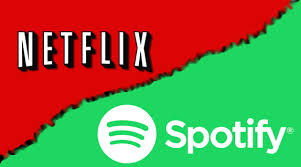The recent news about the growth of Netflix subscribers reveals a strong and sound business model. Executives prediction of 5m net new users was far below the actual number of subscribers who joined the platform in the past three months (around 7m). Furthermore, more than 6m of them are international clients, meaning that the business is steadily expanding outside the US.
Because both companies are massive, rapidly expanding and active in the media and entertainment industry, Netflix and Spotify are often compared and considered alike enterprises. In reality, there are some important and structural differences that cannot be disregarded.
Although the two offer an all-you-can-stream service in exchange of a monthly fee, Spotify also provides customers with a free of charge subscription, while Netflix does not, having user subscriptions as the main source of revenues. This implies that as thousands of active users of the music stream app are not paying for the service, accepting the limitations that this entails, the Swedish company also relies on revenues from advertisement.
Furthermore, the two industries they are engaged in, are indeed very dissimilar. First, in terms of production expenses: while almost anybody can produce and broadcast a song, films and series are extremely more costly. This is translated into different incentives for producers: on the one hand, artists and songwriters are likely to rely on as many platforms as possible to increase the diffusion of their pieces to extrapolate most value out of them. On the other, to start the process, filmmakers need sponsors who spread the risk they face by investing in more than one production.
With respect to this, it can be highlighted that Netflix is also involved in the creation of content, while Spotify is not. The former therefore is both a producer and a distributor, while the latter merely offers a product that can be easily found on other platforms.
Spotify is in a weak position when setting prices. In particular, its costs rise as more people subscribe to the platform and stream the song because labels, that still play a major role in the industry, generally pay artists per user who listens to their songs. For this reason, scalability constitutes an issue for the company. Instead, Netflix enjoys a reduction in its per unit costs as more users subscribe to the platform, becoming over time a crucial partner that enables studios to enlarge their reach.
Only the following years will tell us whether Spotify succeeds in the difficult task of transforming its business model into a more sustainable one or whether, after having changed the way people listen and pay for music, it will be replaced by some other company.
Sources:
https://www.barrons.com/articles/spotify-why-it-is-and-isnt-like-netflix-1522939226
https://www.bloomberg.com/news/articles/2018-03-23/why-spotify-can-t-scale-like-netflix
https://www.ft.com/content/f6512c08-d163-11e8-a9f2-7574db66bcd5
https://markets.businessinsider.com/news/stocks/spotify-stock-price-netflix-cant-compare-2018-4-1020586061
https://www.valuechampion.sg/5-reasons-why-spotify-not-netflix-music

